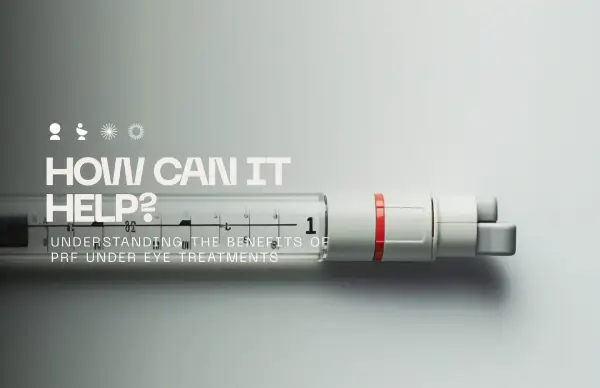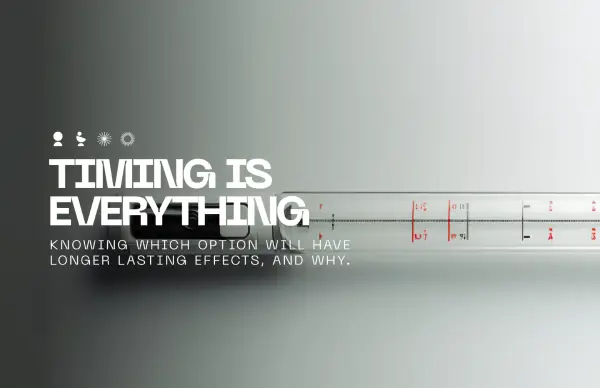Blog
PRF vs filler undereye – what is better!

Contents
What is PRF?
The benefits of PRF under eye treatments
What is filler?
PRF injection vs. filler: Which is better?
PRF injections vs. filler: Which lasts longer?
PRF injections vs. filler: The winner depends on you
Platelet-rich fibrin (PRF) injections have been making the rounds online. Many say this all-natural treatment may be one of the best under eye treatments out there. Where does it stand compared to other options, like fillers?
The under eyes are a common problem area for people of all ages. Dark circles, scarring, sunken eyes, and crow’s feet can make you look tired and aged.
What makes them even more bothersome is that they’re challenging to treat. Eye creams and cucumber slices can only take you so far. Let’s unpack PRF treatments vs. fillers and how they can change up your under eyes.
What is PRF?
People tend to confuse PRF injections with PRP facials. They both use platelets, but PRF shots work gradually and last longer.
Platelet therapy may sound complex or unnatural. It’s actually one of the most natural treatments on the market.
Our bodies naturally create platelets that are present in the blood. They’re small, colorless cell fragments made by the bone marrow. When we have injuries, platelets bind together to form clots that stop bleeding.
Extracting the platelets for under eye treatments can make you look years younger. It delivers long-lasting anti-aging effects by stimulating collagen and smoothing out the area.
PRF uses your body’s own healing process to revive and repair skin conditions. It triggers the production of collagen, heals broken tissue, and keeps the skin elastic.
Platelets are life-saving, blood-clotting cells that contain high concentrations of growth factors.
PRF procedure
The PRF procedure seems mystical, but it’s actually not. This treatment uses the most natural ingredient: your blood. The process doesn’t involve complex chemicals or additives.
Here are the steps involved in a PRF under eye treatment:
- The medical practitioner extracts a small tube of blood.
- The blood sample is separated by centrifuge into platelet, fibrin, and plasma components.
- A controlled cooling and heating process separates the platelets. It transforms them into a natural gel filler. This process also forms an intermolecular bond between the growth factors and leukocytes.
- The practitioner injects the PRF gel filler under the eyes. You may feel slight discomfort or a minor sting. Most patients report minimal or no pain during and after the procedure.
The benefits of PRF under eye treatments
Platelet-rich fibrin filler is packed with growth factors and protein. This mix stimulates collagen and elastin, which heals and protects the skin.
PRF fillers deliver a prolonged release of growth factors. They work consistently to improve skin conditions. The effects take hold in the coming weeks after the procedure.
Here are some benefits of PRF under eye treatments:
- Long-term results lasting up to one year
- Growth factors have powerful anti-aging effects
- All natural treatment with no additives or harmful chemicals
- Suitable for most patients
- Minimal side effects
- Treats a variety of under eye skin concerns, including texture and pigmentation
What is filler?
Dermal filler is a nonsurgical cosmetic procedure. It involves a range of substances injected under the skin.
Many people get dermal fillers to enhance or plump up areas on the face. Celebrities like Kylie Jenner have opened up about getting this treatment. Stars commonly use it to get juicy lips and reduce wrinkles.
The filler adds plumpness to saggy skin by filling in the spaces where volume is lost. It enhances facial features and provides more youthful, bouncy-looking skin.
There are many types of fillers available. It’s crucial to get this treatment under the guidance of a professional. It can cause bumpy looking skin if the application isn’t smooth.
Dermal filler procedure
Compared to PRF injections, dermal fillers have a more simple application. The practitioner’s ability is the main thing that affects the treatment. Here’s what you can expect from a typical session:
- The healthcare practitioner cleans your under eye. This area is sensitive and may cause excessive blinking and squinting. Movement affects the application. They may apply an anesthetic ointment to numb the area and ensure a smooth result.
- Once you’re comfortable, the practitioner uses a thin needle to inject small amounts of filler under your skin.
- The practitioner may inject the filler into multiple areas for serious concerns.
- The treatment typically lasts around 30 minutes to an hour. Most people don’t experience any pain, but the needle can cause a slight pinch when entering the skin.
Types of dermal fillers and their benefits
There are many types of dermal fillers. Practitioners recommend them based on your unique skin care needs.
Calcium hydroxylapatite
Our bodies naturally produce calcium hydroxylapatite. This mineral-like compound is found in human bones. It’s also known as Radiesse.
Practitioners typically use this compound for moderate to severe wrinkles. This treatment is used to treat nasolabial folds, deep lines, and marionette lines.
People with HIV or wasting diseases benefit greatly from calcium hydroxylapatite fillers, as they often experience facial weight loss. This treatment plumps up the cheeks and facial contours.
Hyaluronic acid
Our bodies naturally create hyaluronic acid to keep our tissues and joints lubricated. It’s a popular filler option because it instantly creates dramatic improvements. Here are the skin conditions it’s typically used for:
- Marionette lines
- Redefining lip border
- Scars from burns or wounds
- Acne scarring
- Deep smile lines
- Crow’s feet
- Frown lines
- Smoker’s lines
- Cheek depressions
We offer hyaluronic acid fillers that our practitioners inject with a steady hand. Our clients leave with smooth, plump skin and immediate results.
Polyalkylimide
Polyalkylimide is a semi-permanent filler that’s also known as Aquamid. Unlike the subtleness of PRF under eye procedures, polyalkylimide delivers dramatic adjustments.
Plastic surgeons typically use polyalkylimide to improve facial wasting from HIV treatments. They also use it for more severe wrinkles along the nasolabial folds.
Aquamid plumps thin lips and replaces facial volume due to aging. It also enhances cheekbones and can improve facial proportions.
Polyalkylimide is effective, but it can cause clinical complications over time. It may create an acute inflammatory response when degrading in the body.
Polylactic acid
Polylactic acid is also known as Sculptra. It’s a stimulator filler that boosts your body’s own production of collagen.
Sculptra is a non-toxic, biodegradable filler that’s been used for over 40 years. It’s particularly effective in treating the lower half of your face.
Polylactic acid plumps lips and improves laugh lines by filling in the space. It’s also an effective treatment for deep nasolabial folds.
Polymethyl-methacrylate microspheres (PMMA)
PMMA is a semi-permanent filler with long-lasting results. It’s also known as Bellafill. Plastic surgeons typically use it when more permanent solutions are necessary.
This filler treats deep furrows and wrinkles, especially nasolabial folds. It’s also useful for pitted scars and thin lips.
The downside of PMMA is a number of injections are needed and it takes around three months for the effects to show. Surgeons should be well-trained in threading or tunneling methods. This filler can be visible under the skin without the proper technique.
PRF injections vs. filler: Which is better?
The key difference between PRF and filler is the time it takes for effects to show. Fillers create an immediate and dramatic result. PRF takes up to three months to take full effect.
Patients with autoimmune diseases aren’t good candidates for hyaluronic acid. PRF under eye treatments offers them similar results with a lower risk.
Hyaluronic acid fillers plump up skin and make the under eye area appear less sunken. They reduce the appearance of wrinkles and fill crow’s feet. However, fillers don’t do much to even out skin texture and scars.
PRF helps the skin plump up naturally. The effects are less dramatic and more subtle than fillers. It may not be as useful for instant results from deep wrinkles and crow’s feet, but it reduces them over time.
Compared to fillers, PRF evens out skin tone and texture. This effect is especially beneficial for people with under eye pigmentation or scars. It helps your skin restore itself.
Younger people may not have under eye wrinkles, but pigmentation is a common concern. Fillers don’t help much in this spectrum. PRF can stimulate collagen and growth factors from the inside out. It evens out the under eye area and gives you smooth skin.
It’s hard to say which treatment option is better. People who want more subtle results should opt for PRF injections. Those searching for immediate and dramatic effects typically prefer fillers.
PRF is naturally derived, with no preservatives, additives, or the likes. People with hypersensitivity or certain illnesses are more likely to tolerate it. It’s made from their own platelets, so it doesn’t usually cause any extreme reactions.
Fillers may require more frequent touch-ups. The frequency depends on individual factors that affect how quickly they dissolve. You typically need 3–4 monthly PRF injections, with yearly touch-ups. PRF is lower maintenance for most people.
Bear in mind that fillers won’t help with pigmentation. In fact, they can make your under eyes appear baggy if you have dark circles.
Do you want to test if your under eye problems are caused by hollowness or pigmentation? Hold a mirror under overhead lighting. Look up towards the light. You have sunken eyes if the shadow disappears. Pigmentation is the culprit if the shadow is still there.
PRF injections vs. filler: Which lasts longer?
Dermal fillers typically last 6–12 months. The under eyes typically don’t get a lot of movement, so the effects last longer. They can sometimes last for years; similar to Botox treatments.
PRF injections gradually improve the texture and plumpness of the under eye area. PRF results usually occur 3–6 months after treatment. The effects remain for about a year, but they can last longer, especially in younger people.
Stick to proper aftercare guides to ensure your treatment lasts as long as possible. It’ll also help avoid negative reactions.
Follow these tips to care for your under eye area after fillers:
- Avoid alcohol for two days after fillers.
- Keep makeup and skincare products away from the area. Do this for the first four hours after treatment.
- Stay away from sun beds and extreme heat or cold.
- Avoid exercise for two days after treatment.
Care for your PRF under eye procedures with these tips:
- Avoid NSAIDs for seven days after treatment.
- Don’t use ice on the area. Swelling is a sign that the treatment is working normally.
- Avoid water-related activities, including showering, for 24 hours post-PRF.
- Refrain from exercise for 24 hours.
- Don’t consume anti-inflammatory nutritional supplements for seven days.
PRF injections vs. filler: The winner depends on you
PRF under eye treatments are an effective, all-natural solution to eye bag woes. The main ingredients are platelets derived from your own blood sample. It stimulates collagen production, smoothes wrinkles, and evens skin tone.
Fillers are also an excellent under eye treatment. They don’t improve pigmentation or skin texture as much. They do, however, give you instant, dramatic results and are very effective at plumping the area.
Book an appointment with LIVV Natural to chat about your under eye concerns. Our naturopathic doctors will help you find the best option for your needs.
Author: Dr. Jason Phan NMD – Founder of LIVV Natural – Anti-aging – regenerative medicine – peptide therapy


